Key takeaways:
- Abstract sculpture art invites personal interpretation, allowing viewers to connect their emotions with the work.
- Choosing materials impacts both the creative process and the emotional expression of sculptures.
- Overcoming creative challenges fosters innovation and personal growth in the artistic journey.
- Sharing the sculptural process online builds community, encourages collaboration, and normalizes the experience of imperfection.
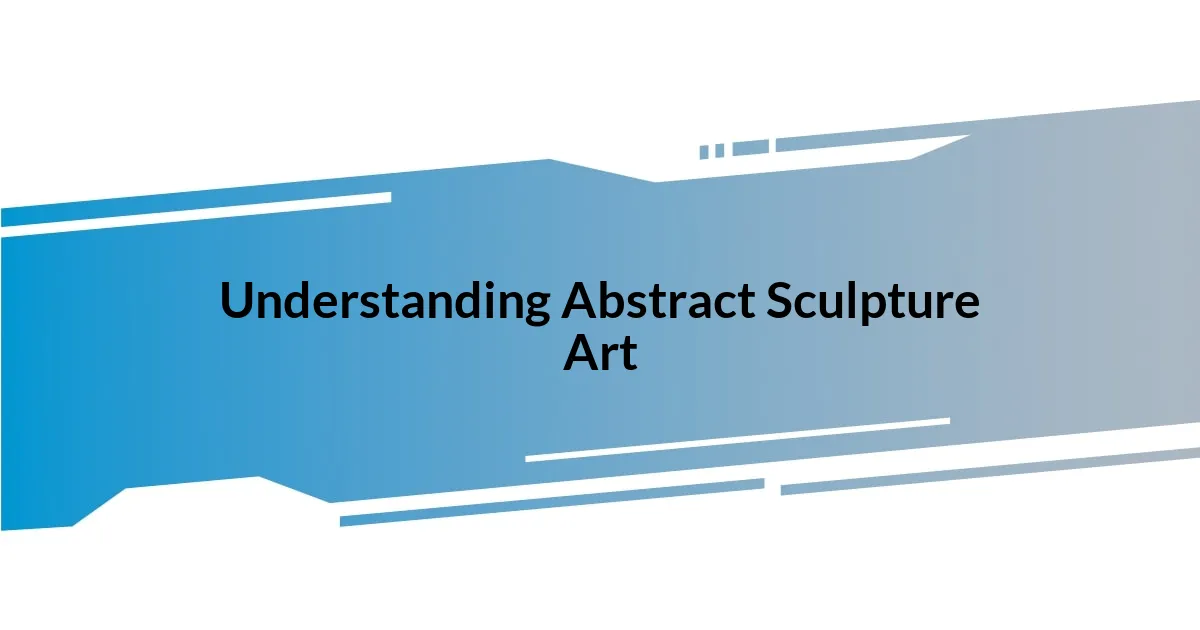
Understanding Abstract Sculpture Art
Abstract sculpture art is a fascinating expression of creativity that transcends traditional forms. I remember my first encounter with a large abstract piece at a local gallery; it towered over me, a whirlwind of shapes that seemed to defy gravity. How can simple materials provoke such a profound emotional response?
What I find captivating about abstract sculpture is its ability to invite interpretation. Each viewer can project their thoughts and feelings onto the work, creating a personal connection that may differ vastly from someone else’s experience. I once stood in front of a jagged, rusted steel piece that stirred memories of resilience within me, as if the sculpture mirrored the struggles we all face.
In abstract sculpture, the absence of recognizable forms often allows the creator’s emotions to shine through. I’ve often asked myself what a specific piece might say about the artist—are they feeling hopeful, conflicted, or liberated? Engaging with these works encourages a dialogue not just between the viewer and the sculpture but also within ourselves, making the experience deeply personal and reflective.
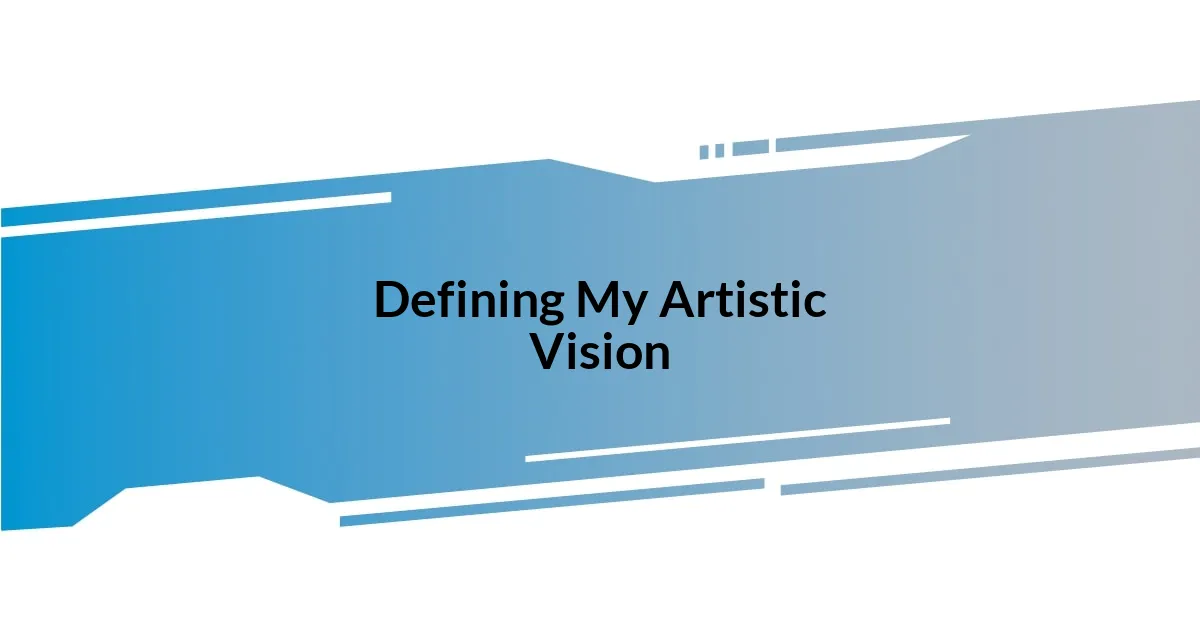
Defining My Artistic Vision
Defining my artistic vision is like peeling back layers of my own emotional landscape. The journey began when I discovered the raw power of materials—each one tells its own story. For instance, I once sculpted a piece from reclaimed wood, a medium that spoke of resilience and history. As I carved into the surface, memories of my childhood, where I played in a forest near my home, flooded my mind. This experience shaped my vision, pushing me toward creating sculptures that resonate not just visually, but emotionally as well.
One crucial aspect of my artistic vision is the relationship between form and space. I often think about how the surrounding environment interacts with my sculptures. A piece positioned in a sunny park might evoke joy, while the same sculpture in a dimly lit gallery creates a sense of contemplation. I vividly recall a moment when I placed a delicate installation outdoors—its shadows danced on the ground, transforming not just the sculpture but also the space around it. It made me realize how vital context is to the narrative that each piece conveys.
Ultimately, my artistic vision is about exploration and dialogue. I strive to create works that invite viewers to reflect on their own emotions and experiences. I remember speaking with someone who found solace in a chaotic piece I created; it mirrored their personal struggles, revealing the transformative power of art. It’s this connection that fuels my passion—art can bridge the gap between individual experiences, allowing a shared understanding to flourish.
| Aspect | Description |
|---|---|
| Materials | Use of reclaimed materials to evoke history and emotion |
| Form & Space | The interplay between the sculpture and its environment, affecting perception |
| Dialogue | Encouraging viewer reflection and personal connections through art |
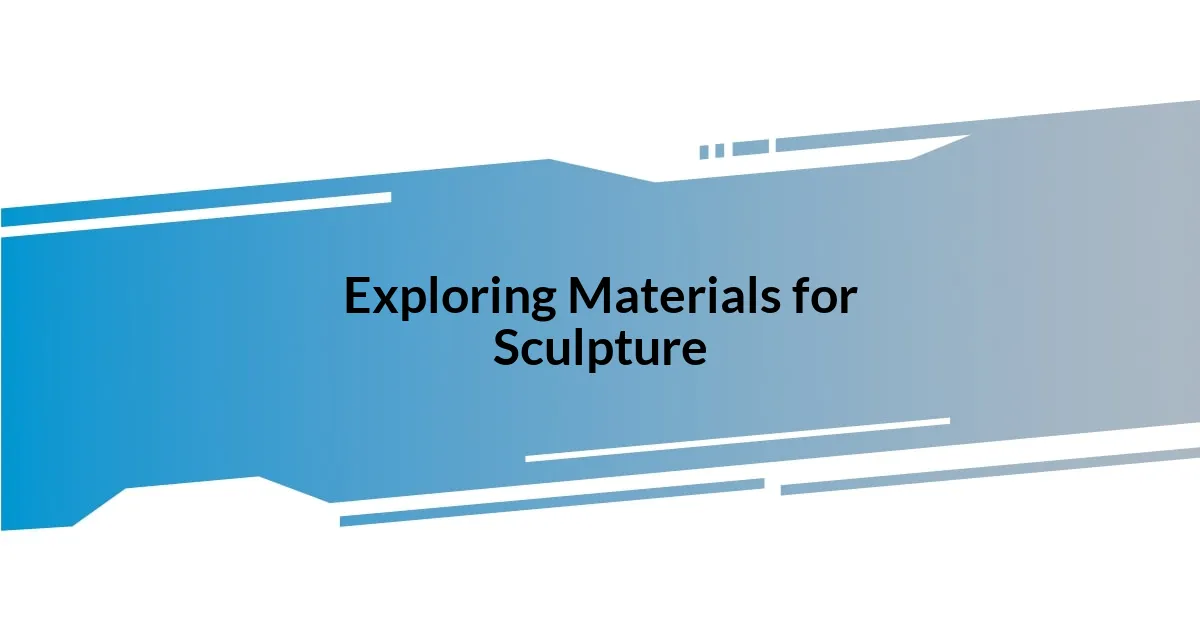
Exploring Materials for Sculpture
When exploring materials for sculpture, I’ve found that the choice of medium can significantly impact both the creation process and the final expression of the work. I distinctly remember a time when I experimented with clay; the tactile nature of it allowed me to express my emotions more fluidly than other mediums. As I molded the soft earth, I felt a connection like never before—each indentation and curve represented a part of my journey. It’s amazing how materials can almost dictate the direction of our artistic expression, capturing not just forms but feelings.
Here are some materials I’ve discovered to be particularly powerful in abstract sculpture:
- Metal: Provides strength and permanence, carrying a sense of durability and resilience. I crafted a piece from twisted steel rods, and the harsh edges became metaphors for life’s challenges.
- Wood: Offers warmth and a natural aesthetic, often evoking memories. A sculpture made from aged wood brought to life stories from nature and childhood.
- Clay: Facilitates spontaneous creativity, perfect for exploring emotions in real-time. The malleability of clay made each session a reflection of my inner state.
- Glass: Represents fragility yet beauty, playing with light and shadow in captivating ways. One time, a glass sculpture refracted sunlight, casting a beautiful dance of colors onto the floor, which felt like a moment of joy frozen in time.
- Stone: Imparts a sense of timelessness and permanence, with each chisel stroke taking on a meditative quality. I often find that shaping stone allows me to carve not only the material but also my thoughts.
Choosing a material often feels like choosing a voice for my emotions; each medium offers a unique way to communicate. I’ve learned to embrace experimentation, as sometimes it leads me down unexpected yet rewarding paths, revealing deeper connections to my work.
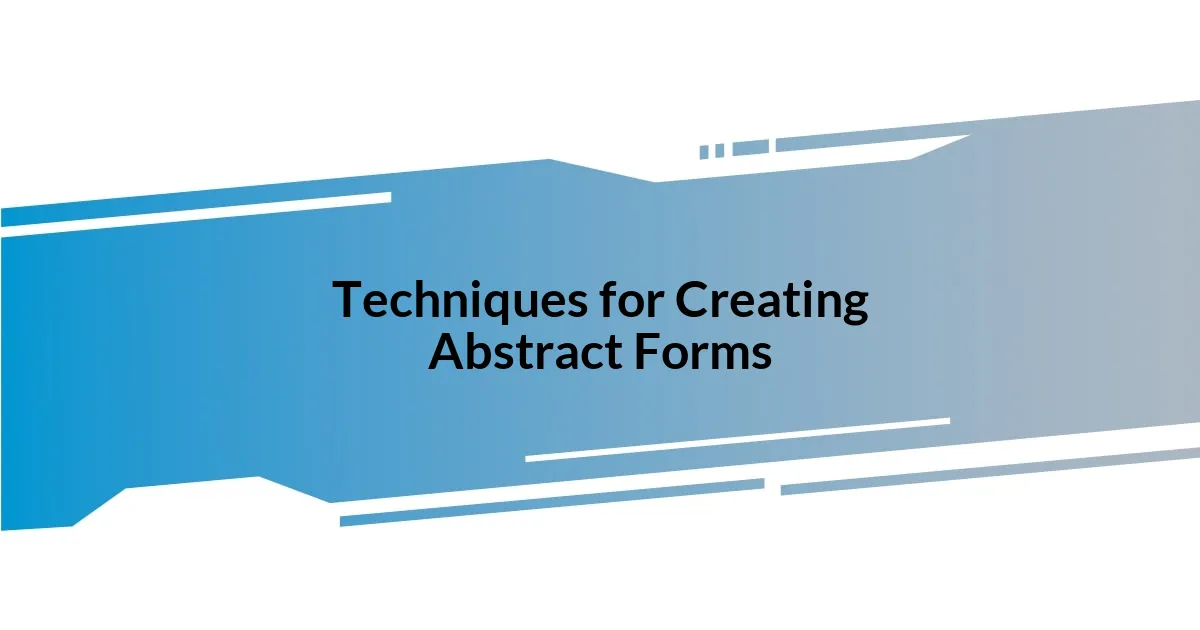
Techniques for Creating Abstract Forms
Creating abstract forms involves a variety of techniques, each serving as a tool to express emotion and thought. One technique I’ve found particularly thrilling is the use of layering in my sculptures. I remember working on a large piece where I stacked different types of materials—a harmonious blend of metal and wood. The contrast brought out raw emotions, revealing hidden stories within each layer. When you layer materials, it’s almost like telling a narrative that unfolds with every glance. How do you think different textures might impact your perception of art?
Another technique I often explore is the manipulation of negative space. The beauty of abstraction lies not just in what is present but in what is absent. In one of my sculptures, I intentionally carved out specific sections, allowing light and air to flow through effortlessly. This decision transformed the piece from a solid form into a dialogue with its environment. I encourage you to consider how the absence of material can evoke feelings—what do you think the negative space in a piece says about the whole?
Gradation is also a key technique I utilize in my work. I love to explore how different colors or textures transition smoothly into one another. A standout moment for me was when I blended shades of blue and green in a ceramic piece, watching the colors flow seamlessly together. It reminded me of the ocean meeting the shore—an ebb and flow that feels both calming and dynamic. Have you ever noticed how gradients can evoke different moods in art? The right transition can communicate a sense of motion or stillness, further enriching the viewer’s experience.
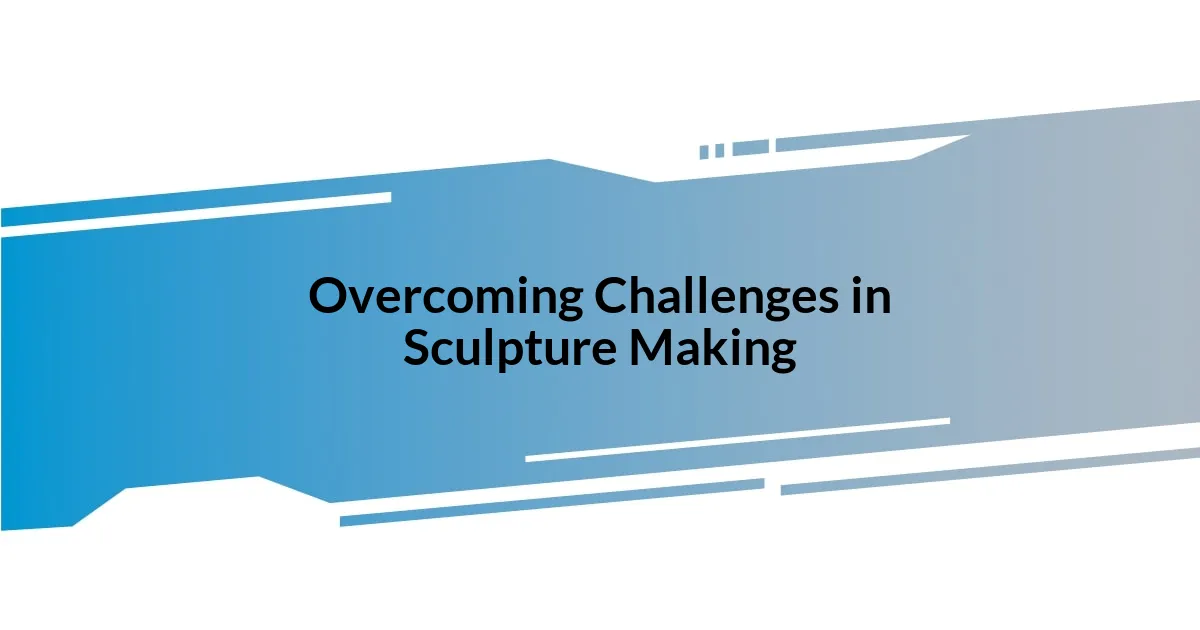
Overcoming Challenges in Sculpture Making
Overcoming challenges in sculpture making is an integral part of the artistic journey. I remember a significant struggle when I attempted to create a large outdoor sculpture. The scale was daunting, and I often found myself questioning if my vision could exist in such a grand form. It was during one particularly frustrating day that I realized instead of focusing on the overwhelming size, I could break the project into manageable sections, allowing me to concentrate on smaller details. Do you ever feel that way about your own challenges?
Technical obstacles can be equally daunting. I faced a moment when my original design had to be altered because the weight distribution in my metal sculpture was off, threatening its stability. Rather than see this as a setback, it sparked a creative solution. I explored new support structures that not only reinforced the piece but also enhanced its aesthetic. It turned into an unexpected opportunity to innovate—have you experienced a similar moment where a challenge pushed you towards a more creative answer?
Emotional hurdles, too, can impact a sculpture’s development. At one point, I found myself grappling with self-doubt, worried that my latest piece didn’t resonate emotionally with me. I remember stepping back and engaging with my feelings through drawing and journaling. This introspective process allowed me to connect with my intentions anew, breathing life back into my work. Isn’t it fascinating how sometimes, stepping away is exactly what we need to overcome our creative blocks?
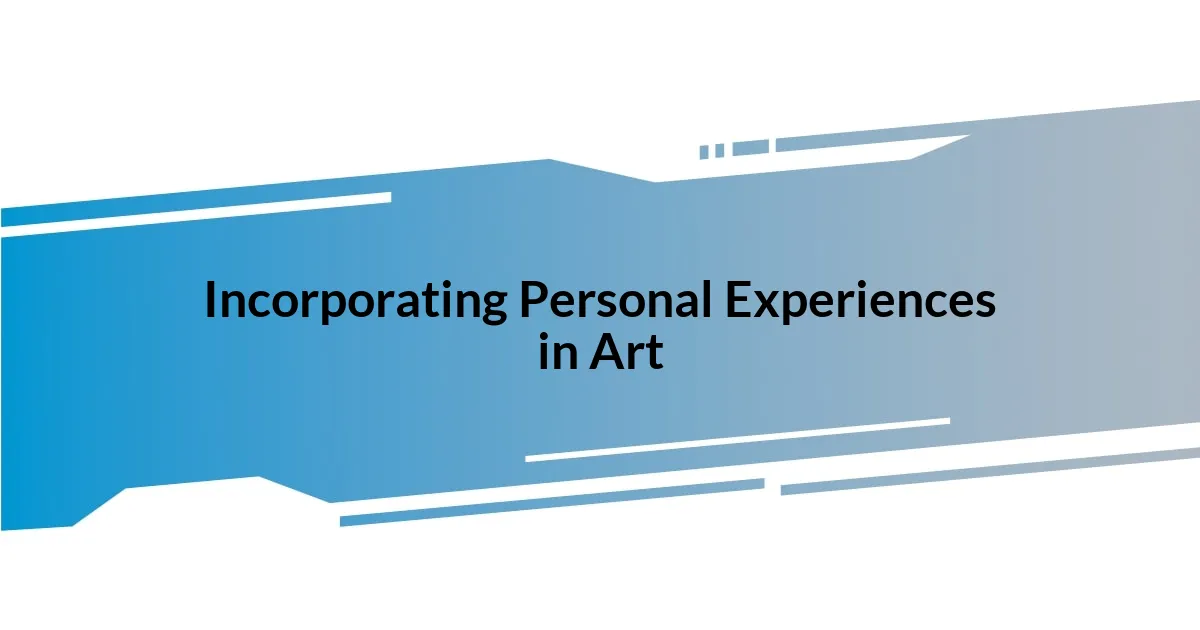
Incorporating Personal Experiences in Art
Incorporating personal experiences into my art transforms the creative process from merely technical to deeply meaningful. I distinctly remember a piece inspired by a challenging phase in my life, where I used fragmented shapes to symbolize feelings of confusion and loss. Each piece, however unrefined, represented a moment of my journey, allowing viewers to connect on a personal level. Have you ever created something that felt like a reflection of your emotions?
I find that my sculptures often carry hints of my life experiences, echoing moments of joy and sorrow. For instance, during a particularly happy summer, I crafted a vibrant kite sculpture, using flowing lines and lively colors to capture that sense of freedom and elation. As I shaped the materials, I relived those cherished memories, translating emotions into tangible form. What if the pieces you create reflect your own stories, too?
Moreover, my interactions with different cultures also shape my work. When I traveled to Japan, I was enchanted by the delicate balance in their gardens. It inspired me to create a series of sculptures that integrated simplicity and elegance, mimicking the quiet beauty I experienced there. The process became a dialogue between my past and the influences I encountered. How do your travels or experiences color the art you create?
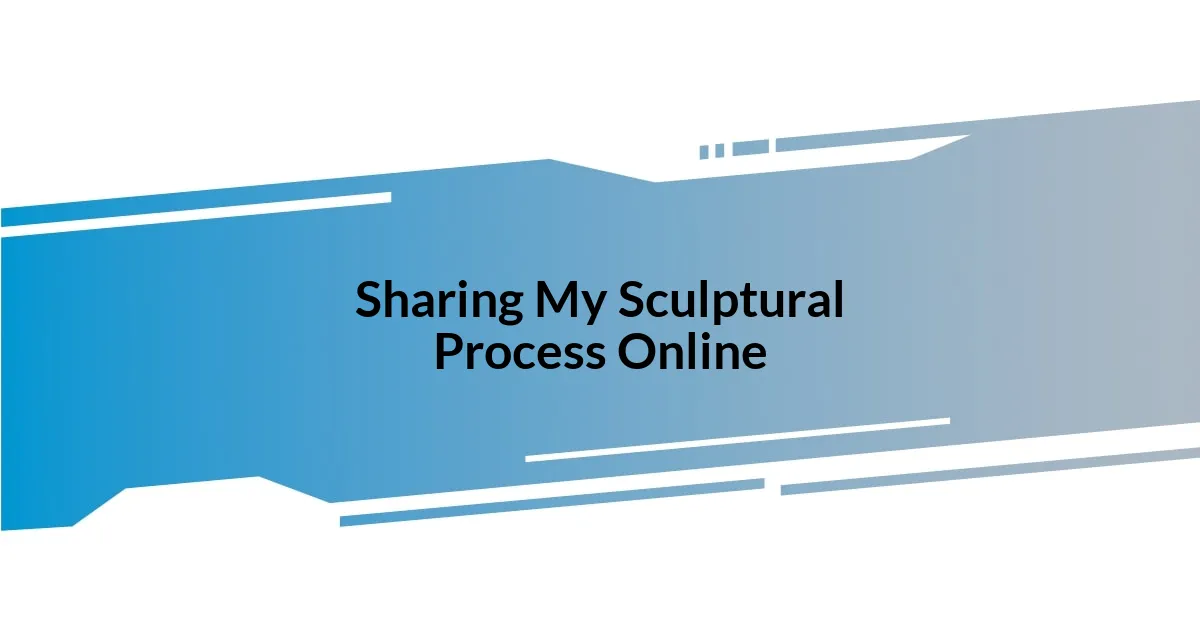
Sharing My Sculptural Process Online
Sharing my sculptural process online has been a game-changer for me. I vividly recall the first time I posted a time-lapse video of me sculpting—it felt vulnerable, but also thrilling. Watching people react in real-time, sharing their thoughts and questions, made me realize how much we can learn from each other. Have you ever felt that same thrill when you received feedback on your work?
The engagement I receive on social media sparks new ideas and paths for my creations. For instance, a follower once suggested a technique that I hadn’t considered before, prompting me to experiment with mixed media in my latest project. This collaborative energy is invigorating; it’s like having an audience of fellow artists cheering me on and pushing me to explore new avenues. Isn’t it incredible how a simple comment can lead to a creative breakthrough?
I also believe sharing my process fosters a sense of community around abstract sculpture. I often post about not just the successes, but also the missteps, which resonates with many. I remember sharing a photo of a sculpture that didn’t turn out as planned. The outpouring of support and shared experiences from others made me realize that we all face hurdles, and it’s those candid moments that truly connect us. Don’t you think that embracing imperfection enriches our artistic journeys?